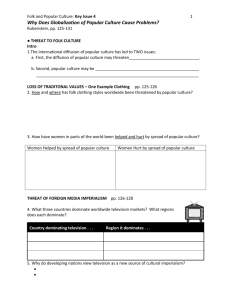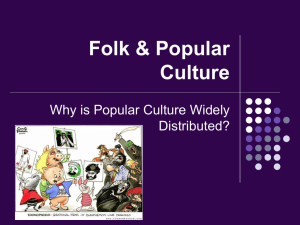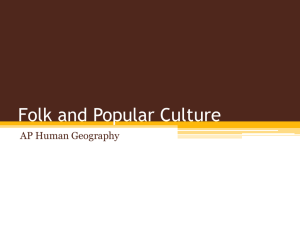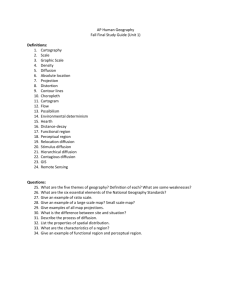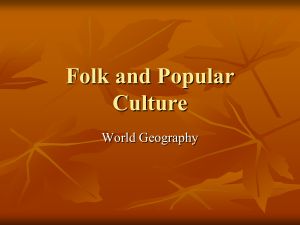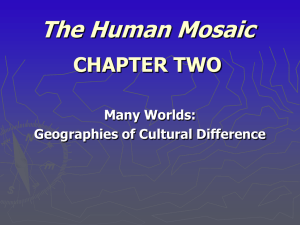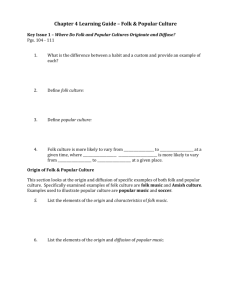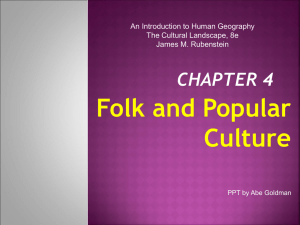Key Issues Chapter 4 - Long Branch Public Schools
advertisement
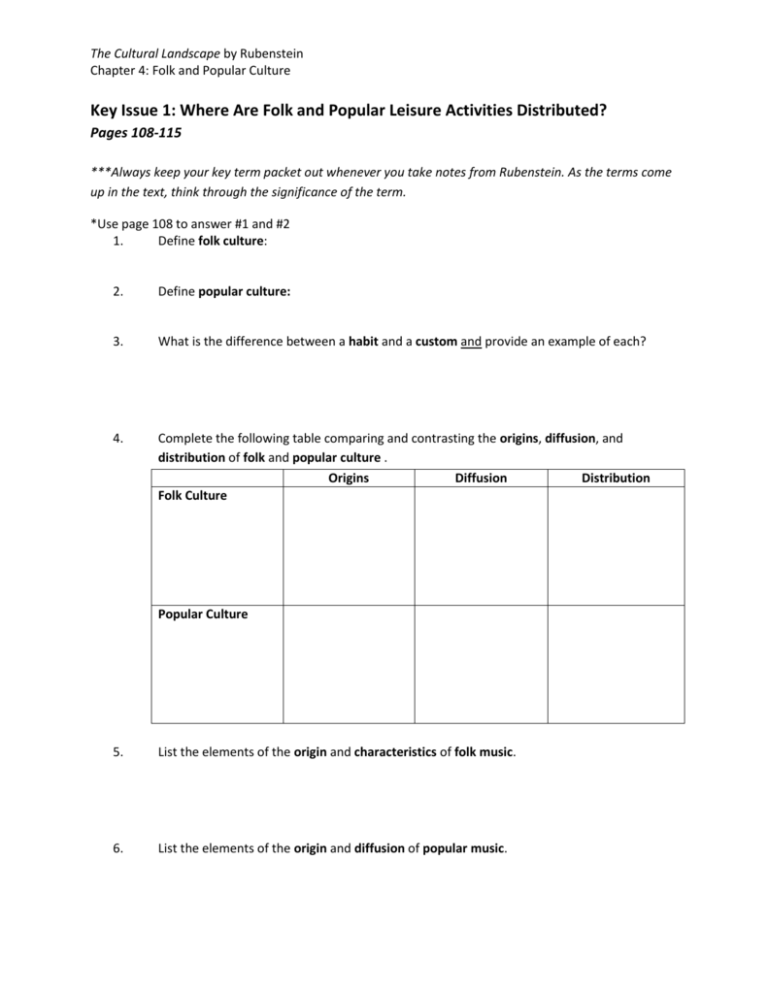
The Cultural Landscape by Rubenstein Chapter 4: Folk and Popular Culture Key Issue 1: Where Are Folk and Popular Leisure Activities Distributed? Pages 108-115 ***Always keep your key term packet out whenever you take notes from Rubenstein. As the terms come up in the text, think through the significance of the term. *Use page 108 to answer #1 and #2 1. Define folk culture: 2. Define popular culture: 3. What is the difference between a habit and a custom and provide an example of each? 4. Complete the following table comparing and contrasting the origins, diffusion, and distribution of folk and popular culture . Origins Diffusion Distribution Folk Culture Popular Culture 5. List the elements of the origin and characteristics of folk music. 6. List the elements of the origin and diffusion of popular music. The Cultural Landscape by Rubenstein Chapter 4: Folk and Popular Culture 7. List the elements of the origin and diffusion of soccer. Be sure to discuss the connection to folk and popular culture. 8. Label popular sports with the countries in which they are the most popular. Key Issue 2: Where Are Folk and Popular Material Culture Distributed? Pages 116-125 1. In Western countries where popular culture predominates, clothing styles generally reflect ________________ rather than particular ________________________. 2. How does clothing style (in this case shoes) indicate the influence of the environment on folk culture? 3. Can you think of other restrictions on clothing styles in developed countries, perhaps in schools? 4. What are three facts about clothing styles associated with popular culture? The Cultural Landscape by Rubenstein Chapter 4: Folk and Popular Culture 5. Food preferences are strongly influenced by ______________________________________. 6. List three different examples of food habits and the unique folk cultures each illustrates. 7. Indicate some food taboos, along with the cultures that practice them, in the chart below. Food Taboos Cultures/Regions Foods/Reasons 8. Consumption of large quantities of snack foods and alcoholic beverages are characteristic of popular culture. Explain how each of these food preferences are expressed regionally, according to culture. 9. Do your food preferences match the predominant ones in your region? 10. In what sense are building materials of folk housing unique? 11. Give three examples of how religious values or belies may influence folk housing. The Cultural Landscape by Rubenstein Chapter 4: Folk and Popular Culture 12. Fred Kniffen, a cultural geographer, has identified three source regions for American folk housing styles: New England, Middle Atlantic and Lower Chesapeake. List the housing styles he identified with each region. a. New England (4 styles) – b. Middle Atlantic (1 dominant style) – c. Lower Chesapeake – 13. Complete the chart below to indicate the decade(s) during which each housing style was dominant and a fact about the particular style of house. Style Minimal Traditional Decades(s) Facts Ranch House Split-Level Contemporary Style Shed Style 14. What are the Neo-eclectic styles of the 1960’s and 1970’s? The Cultural Landscape by Rubenstein Chapter 4: Folk and Popular Culture Key Issue 3: Why is Access to Folk and Popular Culture Unequal? Pages 126-131 1. Give two reasons for which television is an especially significant element of culture. 2. Using the 2005 map in Figure 4-28 on page 126, complete the following chart about television access Television is Universal 3. Television is Common Television is Rare Using the maps on page 128: a. In 2011, where was the Internet most widely available? b. In what regions, then, are there populations still relatively untouched by the Internet? 4. What three countries dominate worldwide television markets? 5. Why do developing nations view television as a new source of cultural imperialism? 6. What are the world’s two largest newspaper organizations? What countries are they associated with? The Cultural Landscape by Rubenstein Chapter 4: Folk and Popular Culture Key Issue 4: Why Do Folk and Popular Culture Face Sustainability Problems? Pages 132-137 1. Where did Amish culture originate, and how did it diffuse to the United States? 2. What is happening to the Amish in the United States today? 3. Label and shade the areas of larger Amish settlements in the U.S. (Use Figure 4-39 on page 132). 4. How has global diffusion of popular social customs had an unintended negative impact on women in India? 5. What are the two ways in which popular customs have an adverse effect on the natural environment? The Cultural Landscape by Rubenstein Chapter 4: Folk and Popular Culture 6. What is a uniform landscape? 7. How and why is this concept utilized by fast-food restaurants? 8. How is the playing of golf and golf courses an example of a popular custom that is not generally in harmony with the local environment? 9. Summarize major sources of waste and how each is recycled (make a chart and/or bulleted list)
